Abstract
Cholesterol-dependent complement activation has been proposed as a factor that might influence the pathogenesis of atherosclerosis. Although antibodies to cholesterol conjugates have been reported, cholesterol is widely regarded as a poorly immunogenic substance. Monoclonal IgM complement-fixing antibodies to cholesterol were obtained in the present study after immunizing mice with liposomes containing high amounts of cholesterol (71 mol % relative to phosphatidylcholine) and lipid A as an adjuvant. Clones were selected for the ability of secreted antibodies to react with liposomes containing 71% cholesterol but not with liposomes containing 43% cholesterol. The antibodies also reacted with crystalline cholesterol in a solid-phase enzyme-linked immunosorbent assay. Binding of monoclonal antibodies to the surface of crystalline cholesterol was demonstrated by electron microscopy by utilizing a second antibody (anti-IgM) labeled with colloidal gold. The immunization period required to induce monoclonal antibodies was very short (3 days) and a high fraction of the hybrid cells (at least 70%) were secreting detectable antibodies to cholesterol. The results demonstrate that cholesterol can be a highly immunogenic molecule and that complement-fixing antibodies to cholesterol can be readily obtained.
Full text
PDF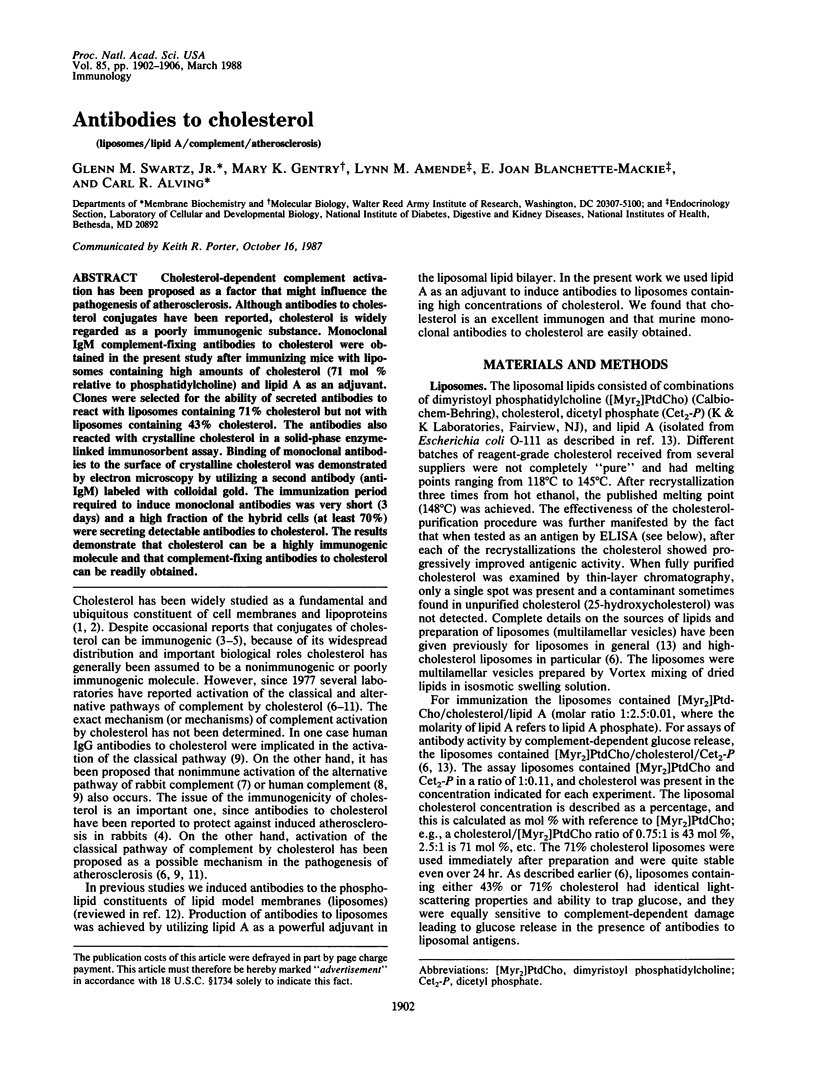
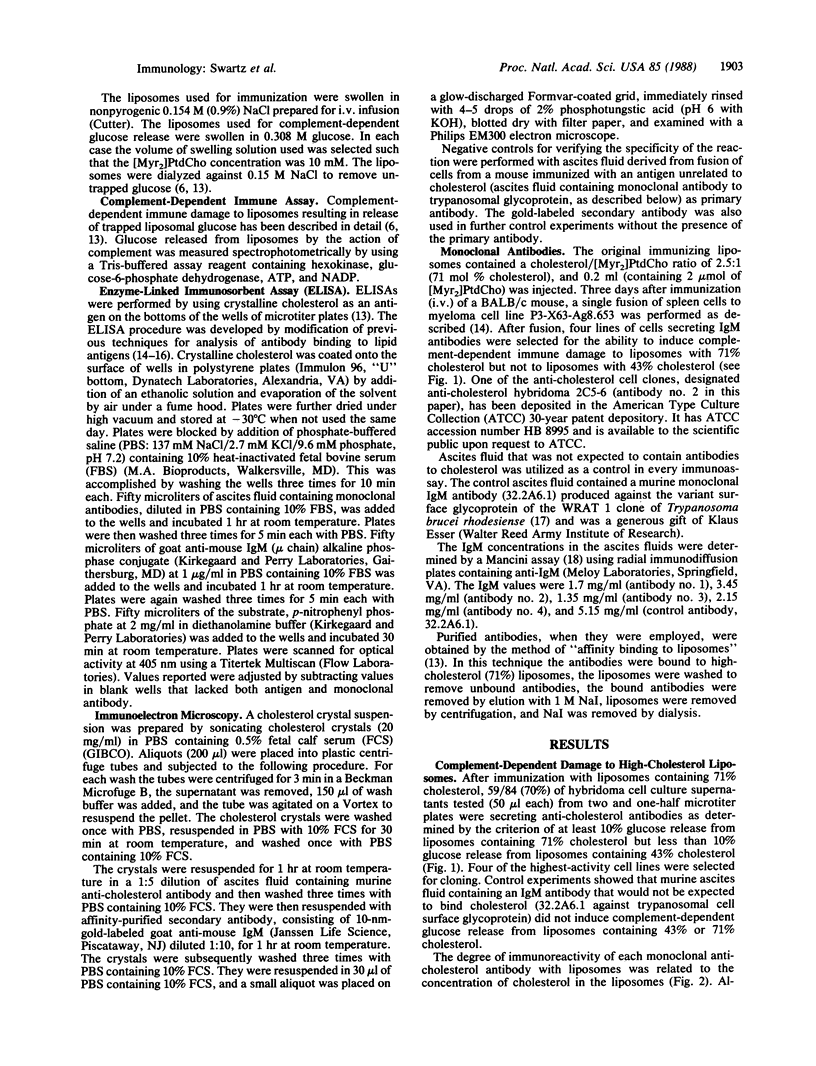
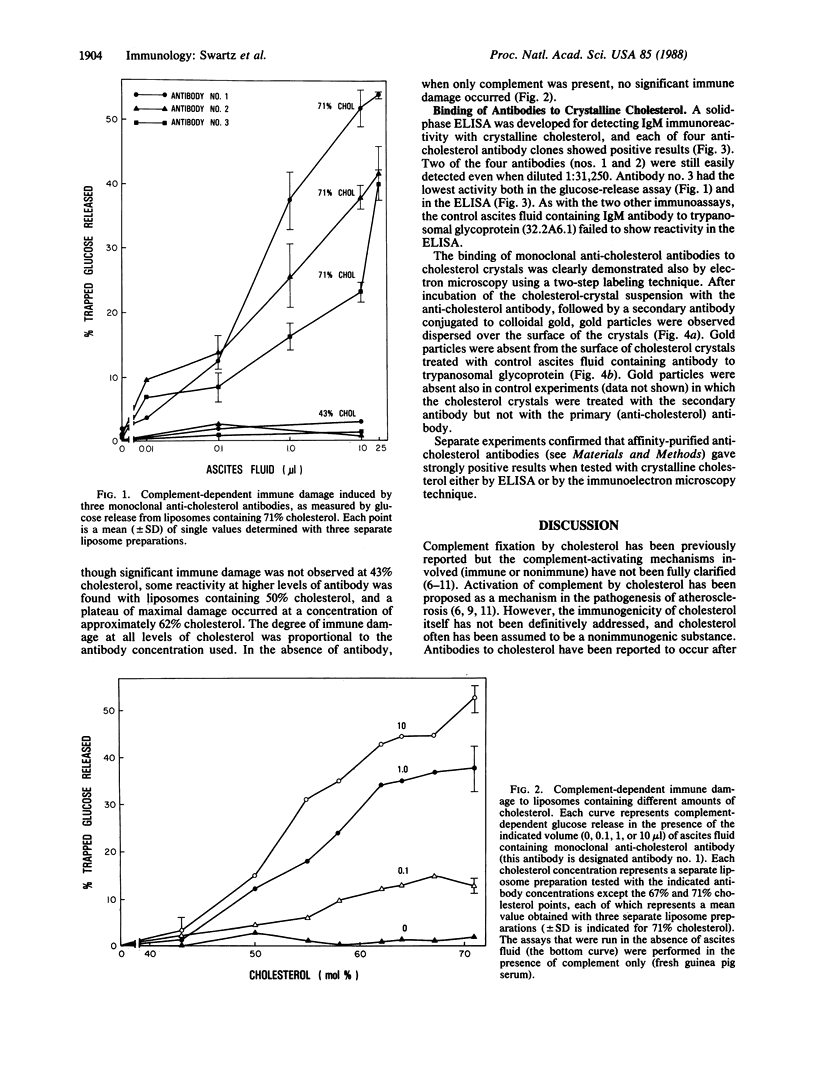
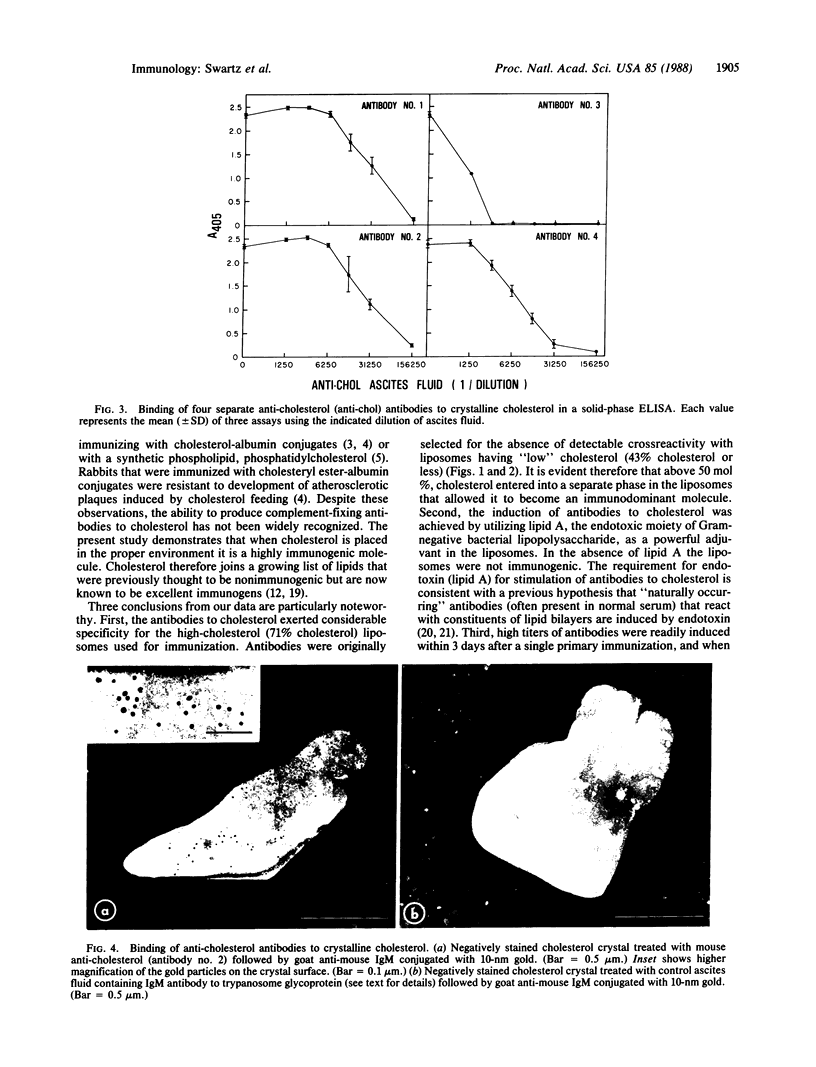
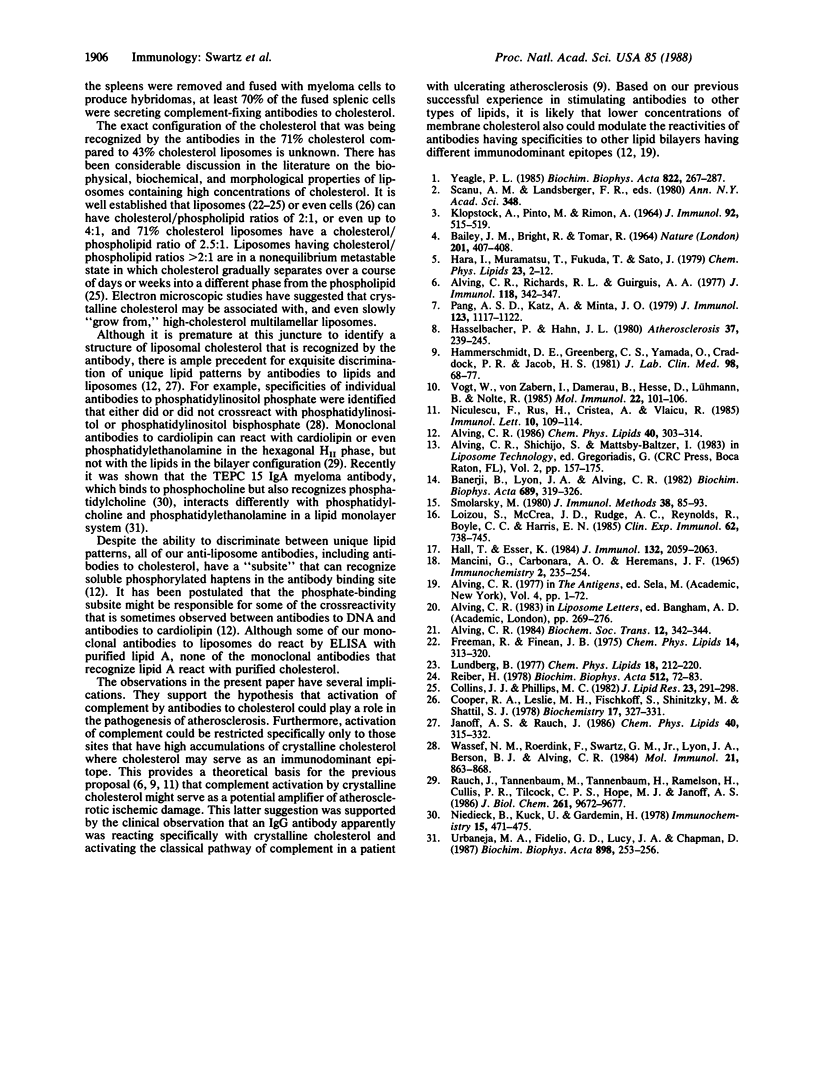
Images in this article
Selected References
These references are in PubMed. This may not be the complete list of references from this article.
- Alving C. R. Antibodies to liposomes, phospholipids and phosphate esters. Chem Phys Lipids. 1986 Jun-Jul;40(2-4):303–314. doi: 10.1016/0009-3084(86)90075-7. [DOI] [PubMed] [Google Scholar]
- Alving C. R. Natural antibodies against phospholipids and liposomes in humans. Biochem Soc Trans. 1984 Apr;12(2):342–344. doi: 10.1042/bst0120342. [DOI] [PubMed] [Google Scholar]
- Alving C. R., Richards R. L., Guirguis A. A. Cholesterol-dependent human complement activation resulting in damage to liposomal model membranes. J Immunol. 1977 Jan;118(1):342–347. [PubMed] [Google Scholar]
- BAILEY J. M., BRIGHT R., TOMAR R. IMMUNIZATION WITH A SYNTHETIC CHOLESTEROL-ESTER ANTIGEN AND INDUCED ATHEROSCLEROSIS IN RABBITS. Nature. 1964 Jan 25;201:407–408. doi: 10.1038/201407a0. [DOI] [PubMed] [Google Scholar]
- Banerji B., Lyon J. A., Alving C. R. Membrane lipid composition modulates the binding specificity of a monoclonal antibody against liposomes. Biochim Biophys Acta. 1982 Jul 28;689(2):319–326. doi: 10.1016/0005-2736(82)90265-6. [DOI] [PubMed] [Google Scholar]
- Collins J. J., Phillips M. C. The stability and structure of cholesterol-rich codispersions of cholesterol and phosphatidylcholine. J Lipid Res. 1982 Feb;23(2):291–298. [PubMed] [Google Scholar]
- Cooper R. A., Leslie M. H., Fischkoff S., Shinitzky M., Shattil S. J. Factors influencing the lipid composition and fluidity of red cell membranes in vitro: production of red cells possessing more than two cholesterols per phospholipid. Biochemistry. 1978 Jan 24;17(2):327–331. doi: 10.1021/bi00595a021. [DOI] [PubMed] [Google Scholar]
- Finean J. B. Cholesterol: lecithin association at molecular ratios of up to 2 : 1. Chem Phys Lipids. 1975 Aug;14(4):313–320. doi: 10.1016/0009-3084(75)90067-5. [DOI] [PubMed] [Google Scholar]
- Hall T., Esser K. Topologic mapping of protective and nonprotective epitopes on the variant surface glycoprotein of the WRATat 1 clone of Trypanosoma brucei rhodesiense. J Immunol. 1984 Apr;132(4):2059–2063. [PubMed] [Google Scholar]
- Hammerschmidt D. E., Greenberg C. S., Yamada O., Craddock P. R., Jacob H. S. Cholesterol and atheroma lipids activate complement and stimulate granulocytes. A possible mechanism for amplification of ischemic injury in atherosclerotic states. J Lab Clin Med. 1981 Jul;98(1):68–77. [PubMed] [Google Scholar]
- Hara I., Muramatsu T., Fukuda T., Sato J. Immunochemical properties of phosphatidyl cholesterol and its homologue. Chem Phys Lipids. 1979 Jan;23(1):7–12. doi: 10.1016/0009-3084(79)90018-5. [DOI] [PubMed] [Google Scholar]
- Hasselbacher P., Hahn J. L. Activation of the alternative pathway of complement by microcrystalline cholesterol. Atherosclerosis. 1980 Oct;37(2):239–245. doi: 10.1016/0021-9150(80)90009-x. [DOI] [PubMed] [Google Scholar]
- Janoff A. S., Rauch J. The structural specificity of anti-phospholipid antibodies in autoimmune disease. Chem Phys Lipids. 1986 Jun-Jul;40(2-4):315–332. doi: 10.1016/0009-3084(86)90076-9. [DOI] [PubMed] [Google Scholar]
- KLOPSTOCK A., PINTO M., RIMON A. ANTIBODIES REACTING WITH STEROID HAPTENS. J Immunol. 1964 Apr;92:515–519. [PubMed] [Google Scholar]
- Loizou S., McCrea J. D., Rudge A. C., Reynolds R., Boyle C. C., Harris E. N. Measurement of anti-cardiolipin antibodies by an enzyme-linked immunosorbent assay (ELISA): standardization and quantitation of results. Clin Exp Immunol. 1985 Dec;62(3):738–745. [PMC free article] [PubMed] [Google Scholar]
- Lundberg B. Properties of mixed vesicles of lecithin: cholesterol up to a 1:2 molar ratio. Chem Phys Lipids. 1977 Mar;18(2):212–220. doi: 10.1016/0009-3084(77)90008-1. [DOI] [PubMed] [Google Scholar]
- Mancini G., Carbonara A. O., Heremans J. F. Immunochemical quantitation of antigens by single radial immunodiffusion. Immunochemistry. 1965 Sep;2(3):235–254. doi: 10.1016/0019-2791(65)90004-2. [DOI] [PubMed] [Google Scholar]
- Niculescu F., Rus H., Cristea A., Vlaicu R. Localization of the terminal C5b-9 complement complex in the human aortic atherosclerotic wall. Immunol Lett. 1985;10(2):109–114. doi: 10.1016/0165-2478(85)90185-3. [DOI] [PubMed] [Google Scholar]
- Niedieck B., Kuck U., Gardemin H. On the immune precipitation of phosphorylcholine lipids with TEPC 15 mouse myeloma protein and with anti-lecithin sera from guinea pigs. Immunochemistry. 1978 Jul;15(7):471–475. doi: 10.1016/0161-5890(78)90076-7. [DOI] [PubMed] [Google Scholar]
- Pang A. S., Katz A., Minta J. O. C3 deposition in cholesterol-induced atherosclerosis in rabbits: a possible etiologic role for complement in atherogenesis. J Immunol. 1979 Sep;123(3):1117–1122. [PubMed] [Google Scholar]
- Rauch J., Tannenbaum M., Tannenbaum H., Ramelson H., Cullis P. R., Tilcock C. P., Hope M. J., Janoff A. S. Human hybridoma lupus anticoagulants distinguish between lamellar and hexagonal phase lipid systems. J Biol Chem. 1986 Jul 25;261(21):9672–9677. [PubMed] [Google Scholar]
- Reiber H. Cholesterol-lipid interactions in membranes. The saturation concentration of cholesterol in bilayers of various lipids. Biochim Biophys Acta. 1978 Sep 11;512(1):72–83. doi: 10.1016/0005-2736(78)90218-3. [DOI] [PubMed] [Google Scholar]
- Smolarsky M. A simple radioimmunoassay to determine binding of antibodies to lipid antigens. J Immunol Methods. 1980;38(1-2):85–93. doi: 10.1016/0022-1759(80)90333-6. [DOI] [PubMed] [Google Scholar]
- Urbaneja M. A., Fidelio G. D., Lucy J. A., Chapman D. The interaction of an anti-lipid antibody (TEPC 15) with a model biomembrane system (monolayer). Biochim Biophys Acta. 1987 Apr 9;898(2):253–256. doi: 10.1016/0005-2736(87)90045-9. [DOI] [PubMed] [Google Scholar]
- Vogt W., von Zabern I., Damerau B., Hesse D., Lühmann B., Nolte R. Mechanisms of complement activation by crystalline cholesterol. Mol Immunol. 1985 Feb;22(2):101–106. doi: 10.1016/s0161-5890(85)80003-1. [DOI] [PubMed] [Google Scholar]
- Wassef N. M., Roerdink F., Swartz G. M., Jr, Lyon J. A., Berson B. J., Alving C. R. Phosphate-binding specificities of monoclonal antibodies against phosphoinositides in liposomes. Mol Immunol. 1984 Oct;21(10):863–868. doi: 10.1016/0161-5890(84)90140-8. [DOI] [PubMed] [Google Scholar]
- Yeagle P. L. Cholesterol and the cell membrane. Biochim Biophys Acta. 1985 Dec 9;822(3-4):267–287. doi: 10.1016/0304-4157(85)90011-5. [DOI] [PubMed] [Google Scholar]



